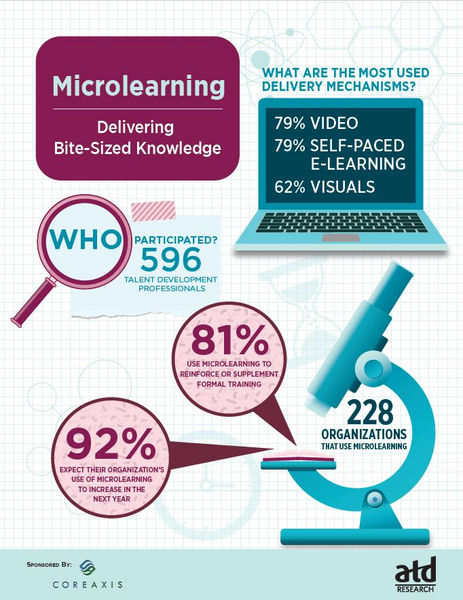ATD Blog
Just How Micro Is Microlearning?
Thu Mar 23 2017


In a world of shrinking attention spans, hectic schedules, and endless distractions, talent development professionals have a lot to consider when developing training for employees. One method many turn to is microlearning, or training that is delivered in bite-sized chunks. But what constitutes “bite-sized”?
Ask anyone in talent development how long microlearning is and you’ll get a plethora of different answers, ranging from a minute to more than 20. So how do you know how long microlearning events and activities should be?
ATD Research recently conducted a short poll on microlearning that focused on two key questions: What’s the ideal length for a microlearning event and what’s the maximum length for a microlearning event? ATD Research surveyed 144 talent development professionals to develop an industry standard. We found that the average maximum amount of time respondents reported that microlearning should be is about 13 minutes. However, the average amount of time participants said microlearning should ideally be is 10 minutes.
These poll results helped inform a separate comprehensive microlearning study conducted by ATD Research. In this study, 228 respondents whose organizations currently use microlearning were asked about the availability of various microlearning lengths and their effectiveness. Participants indicated that the most effective length of time for a microlearning activity is longer than two minutes, but shorter than five minutes (59 percent). Interestingly, participants indicated that about a third of microlearning used at their organization—the highest percentage—was between 10 to 15 minutes long. Thus, while talent development professionals think that microlearning is most effective when it is between two and five minutes, it tends to last much longer.
Putting Research Into Practice
Ultimately, it’s more about what you’re trying to convey to learners than how long training is. Carla Torgerson, senior instructional designer at a large healthcare organization and owner of Torgerson Consulting, illustrates this point by saying, “Like with other forms of education—such as classroom and e-learning—we should be careful about focusing too much on seat time. Instead, we should ask how long it will take to teach the most critical parts of the concept. I often encourage people to self-reference: Would I give up my time in a busy day for this learning? Nobody likes to have their time wasted.”
Opting for longer segments will allow for more detail, while choosing shorter segments may keep learners’ attention better. Ben Locwin, former director of global research and development learning at Biogen and president of Healthcare Science Advisors, explains: “Specifically, those which are short (for example, 2 to 5 minutes) are likely to be more concise, while the 5- to 10-minute microlearnings will often have the capability to delve more deeply into a context.”
Taking this into account, talent development professionals should focus on the content rather than the length, and make the microlearning piece only as long or short as necessary. Ensure that only relevant information is included in training, and exclude extraneous details whenever possible.
Want to learn more about microlearning? Keep an eye out for our upcoming research report on microlearning, Microlearning: Delivering Bite-Sized Knowledge, sponsored by CoreAxis, which will be available at www.td.org/microlearning in early April for a member price of $199. The report can also be purchased at the International Conference and Exposition bookstore for a special price of $75 (this deal is only available in-person at the conference, which will be held May 21 to 24 in Atlanta). You can sign up for the free microlearning webcast on April 19 at 2 p.m., as well.
Visit the ATD Research page to learn more.
More from ATD
